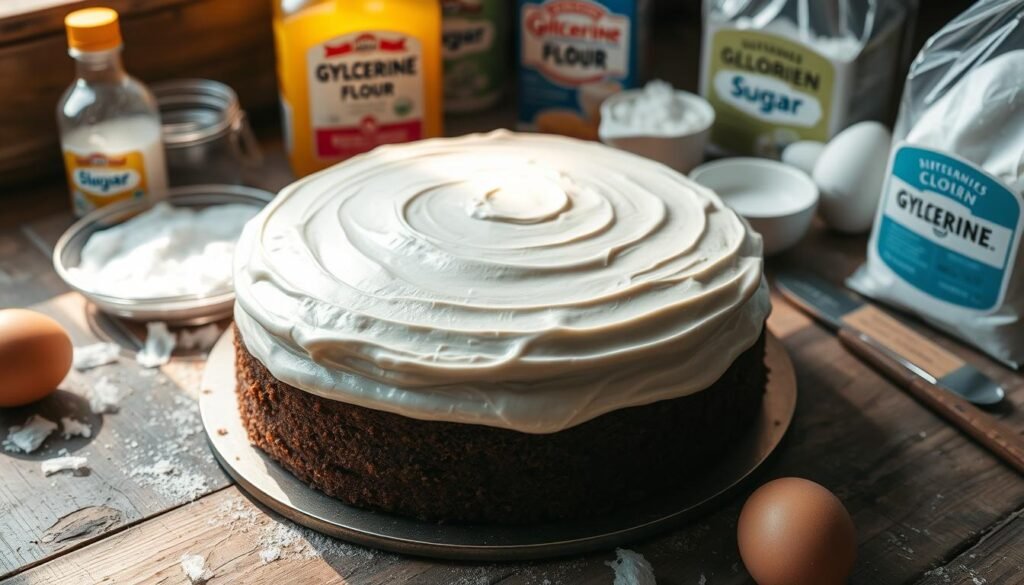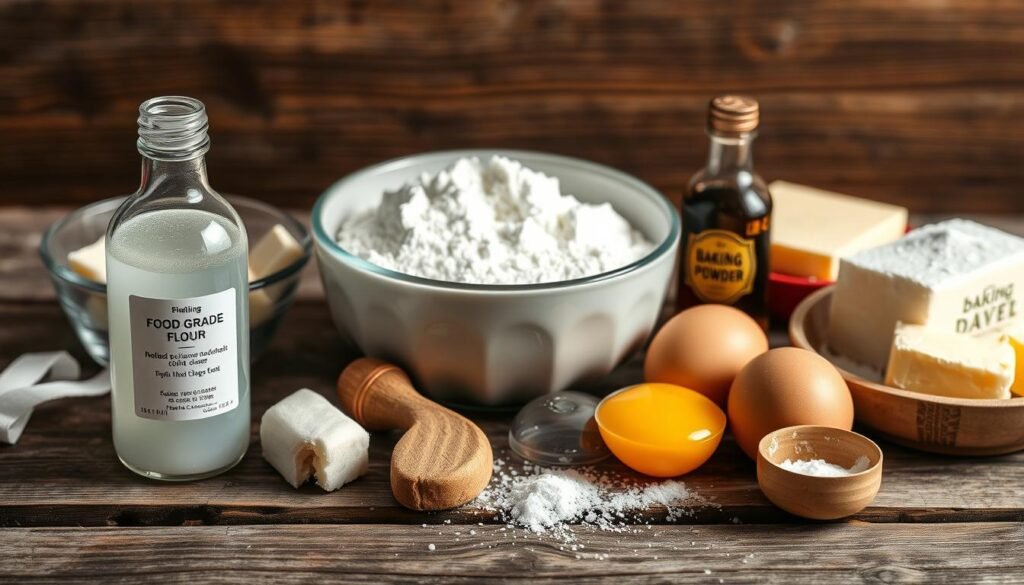Ever wondered how a Cake Glycerine Recipe can prevent your cake from feeling dry or lacking that special melt-in-your-mouth feel? Many home bakers face this issue, wanting their cakes to be as moist and tender as those from a bakery. Imagine serving a cake that looks great and stays fresh and tasty for a long time. Glycerine, a simple yet powerful ingredient, might be the solution you’ve been looking for.
For years, glycerine has been a key ingredient in commercial bakeries. It helps extend shelf life and improve texture. By learning how to use glycerine in baking, you can make your recipes better and achieve results that match the best patisseries with your own Cake Glycerine Recipe.

In this article, you’ll learn how glycerine can change your cake recipes. With a few tweaks, you can make cakes that stay soft and moist for days. Whether you’re new to baking or have lots of experience, knowing how glycerine works as a humectant will open up new delicious possibilities in your kitchen. Are you ready to start this sweet journey?
Key Takeaways
- Glycerine helps extend the shelf life of cakes by retaining moisture, making it an essential ingredient in any Cake Glycerine Recipe.
- Just 1-2 tablespoons of glycerine can be added to most cake recipes.
- Baking with glycerine increases tenderness, making cakes soft for several days.
- Storing glycerine cakes properly preserves their texture and flavor.
- Glycerine is flavorless, ensuring your cake’s taste remains unchanged.
Understanding the Role of Glycerine in a Cake Glycerine Recipe
Glycerine is a versatile ingredient that greatly improves your Cake Glycerine recipe quality. It’s key for getting the right texture and keeping cakes fresh longer. Both professional bakers and home cooks love it for its unique benefits. For a deeper understanding of glycerine’s properties and its various uses in baking, you can learn more here
What is Glycerine?
Glycerine, or glycerol, is a clear, odorless liquid made from plant oils. It’s used in cooking to keep things moist. Adding 1 to 2 teaspoons of glycerine per cup of flour makes cakes soft and moist. Glycerine is also widely used in skincare for its hydrating properties, as explained on WebMD.
The Benefits of Using Glycerine in Your Cake Glycerine Recipe
Using glycerine in baking offers many advantages. Here are some:
- Moisture retention: It keeps cakes from drying out, making them soft and tender.
- Extended shelf life: Glycerine helps cakes stay fresh longer, reducing waste.
- Enhanced flavor: Its subtle sweetness adds depth to baked goods.
- Ingredient stabilization: It helps distribute ingredients evenly, preventing separation.
Many bakers swear by glycerine for these reasons, making it a must-have in their kitchens.
Want to add a sweet and healthy bite to your dessert spread? Be sure to try our Carob Covered Strawberries Recipe for a delightful treat!
How Glycerine Works as a Humectant
Glycerine acts as a humectant, drawing moisture into the cake and keeping it there. This is essential for keeping the cake’s texture and flavor. Cakes with glycerine stay moist and delicious longer.
For the best results, use high-quality edible glycerine from trusted sources like Sharrets Nutritions. Glycerine is not only beneficial for baking, but it’s also known for its ability to hydrate and maintain moisture in various applications, such as skincare. Discover more about glycerine’s benefits here.

| Ingredient | Percentage in Mixture |
|---|---|
| Vegetable Glycerin | 60-70% |
| Distilled Water | 20-30% |
| Food-Grade Alcohol | 10% |
Cake Glycerine Recipe: Essential Ingredients
Creating a moist and flavorful cake starts with the right ingredients. The cake glycerine recipe ingredients are key to the perfect texture and taste. By choosing the right baking ingredients, you can make your cake truly special. Let’s explore the main ingredients and how to customize them for a unique taste.
Ingredient Breakdown for Successful Baking
The basic ingredients for a cake glycerine recipe are:
- All-purpose flour: Gives your cake structure.
- Sugar: Adds sweetness and keeps the cake moist.
- Eggs: Bind the ingredients together and add richness.
- Milk: Makes the cake moist and flavorful.
- Vegetable oil or butter: Adds moisture and flavor.
- Vegetable glycerin: Keeps the cake moist and tender.
For most recipes, add about 2 teaspoons of glycerin for a standard-sized cake. Adjust this amount based on the type of cake. For example, use more glycerin in yellow or vanilla cakes than in chocolate cakes.
Customizing Your Ingredients for Unique Flavors
Customizing your cake recipes lets you create a cake that’s truly yours. Here are some ideas:
- Try different extracts like almond or lemon for unique flavors.
- Use cocoa powder for delicious chocolate cakes.
- Add fresh fruits or nuts for interesting textures.
Remember, glycerin can replace some sugar. It’s sweet like 1 tablespoon of sugar. Being creative with ingredients lets you experiment while keeping the recipe balanced. For example, add 3 teaspoons of glycerin to yellow cakes and only 2 teaspoons to chocolate cakes.

| Type of Cake | Glycerin Amount |
|---|---|
| Chocolate or Red Velvet | 2 tsp |
| Yellow or Vanilla | 3 tsp |
| General Baking | 2 tsp |
Step-by-Step Guide to Your Cake Glycerine Recipe
Making a delicious cake with glycerine needs careful steps and focus. This guide will help you through each step, making sure your baking is fun and successful. First, get all your baking tools and ingredients ready.
Preparing Your Baking Tools and Oven
Start by setting up for success. Heat your oven to 350°F (175°C). This is the best temperature for baking. Also, prepare your baking tools, such as:
- Cake pan (greased and flour-dusted)
- Mixing bowls (for wet and dry ingredients)
- Measuring cups and spoons
- Whisk or electric mixer
- Spatula (for folding ingredients)
- Cooling rack
These tools are key for the right texture and taste in your Cake Glycerine recipe.
Mixing the Ingredients for Optimal Results
It’s time to mix the ingredients for your tasty cake. Start by measuring 2 cups of all-purpose flour, 1 ½ cups of granulated sugar, and 2 teaspoons of baking powder. In another bowl, mix 3 large eggs, 1 cup of milk, 2 tablespoons of glycerine, and 1 teaspoon of vanilla extract. Slowly add the wet ingredients to the dry ones, mixing gently. This avoids a dense cake.
Baking and Cooling Your Cake Glycerine Recipe Properly
Pour the batter into your prepared cake pan and bake at 350°F (175°C). Bake for 30-35 minutes, or until a toothpick comes out clean. After baking, let the cake cool in the pan for 10 minutes. Then, move it to a cooling rack to cool completely. Cooling well keeps the cake moist and soft.
By following these steps and using glycerine, you’ll make a wonderful cake for any event. Enjoy the baking and the delicious outcome!
Tips for Perfecting Your Cake Glycerine Recipe
Getting your cake recipes just right takes focus and detail. Paying close attention to how you measure ingredients is key. Here are some tips to help you improve your baking.
Measuring Ingredients Accurately
It’s important to measure ingredients correctly. Use a kitchen scale for dry ingredients to get precise measurements. Make sure liquid ingredients are at room temperature for better mixing. This helps keep the right balance, which is important when adding glycerine.
Use about 1-2 teaspoons of glycerine per batch. It helps keep your Cake Glycerine recipe moist and fresh for longer.
Avoiding Overmixing for Light Texture
How you mix your ingredients affects your cake’s texture. Overmixing can make cakes dense. Mix your ingredients just until they’re combined.
This helps keep your cake light and fluffy. Remember, your batter should have some air left for a light final product.
With these tips, you’re on your way to mastering your cake glycerine recipe. Follow these steps and see your baking skills grow.
Conclusion
Exploring Cake Glycerine Recipe in baking can change your baking game. Adding 1 to 2 tablespoons of glycerine makes cakes stay moist and tasty for days. This is way better than regular cakes that lose their freshness fast.
This summary shows glycerine’s magic in your Cake Glycerine Recipe. It keeps cakes moist and adds a special texture. Your cakes will feel luxurious and stay light and airy.
Feel free to get creative with glycerine in your recipes. It’s perfect for any occasion or just for a treat. Using glycerine boosts your baking skills, keeping cakes fresh and tasty for longer.
With glycerine, baking ahead of time is a breeze. It gives you more freedom in the kitchen. So, get ready to make your cakes even better with glycerine!
In short, glycerine is a must-have for bakers. It keeps cakes moist and improves their texture. It’s a simple trick that makes every slice special. So, start using glycerine and enjoy the delicious results!
If you’re looking for a festive dessert to go with your cake, try our Libby’s Pumpkin Roll Recipe for a seasonal twist.
FAQ
What types of cakes can benefit from using glycerine?
Glycerine works well for moist cakes like sponge, chiffon, and pound cakes. It makes them more tender and keeps them fresh longer. It’s also good for layered cakes and fondant-covered desserts to keep them moist.
For a fun and delicious treat to pair with your cake, check out our Ogre Toes Recipe, perfect for any occasion!
How much glycerine should I use in a cake recipe?
Start with 1 to 2 tablespoons of glycerine for every cup of liquid in your recipe. Adjust this amount based on the cake type and your taste.
Can I use glycerine in other baking recipes?
Yes! Glycerine can make cookies and brownies more moist. It also improves the texture of fondants and icings.
Will glycerine change the flavor of my cake?
No, glycerine is clear and has no smell. It won’t change your cake’s taste. Its main job is to add moisture and improve texture.
Where can I find glycerine for baking?
You can buy food-grade glycerine at grocery stores, health food stores, or online. Make sure it’s labeled as food-grade for baking.
Can I substitute glycerine with other ingredients?
While glycerine is special, you can try honey or corn syrup as sweeteners. They can keep things moist but might change the flavor. It’s best to experiment and find what works for you.
How does glycerine affect frosting and fondant?
Glycerine makes frosting smooth and prevents it from drying out fast. It also makes fondant more pliable and gives it a better finish.
